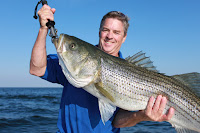Local boat-based fishermen from Northern New Jersey (Think Raritan Bay) and Western New York (Think Jamaica Bay) will soon have 54 new fishing hotspots to explore. Empire Wind 1 and Empire Wind 2 is a “pizza slice” shaped offshore wind lease area, located 13 miles south of Jones Beach, New York, and 19 miles east of Long Branch New Jersey. It is wedged between the shipping channels, with the tip near the infamous offshore hotspot known as the “Cholera Bank”.
This project has been in the works for a while, since 2017, when the lease was awarded, and continues to move forward. Empire Wind 1 (EW1) was one of the first wind energy areas to enter the multi-year process in the Bight. It will be supported locally at the first New York-based “wind port” in South Brooklyn, transforming the South Brooklyn Marine Terminal (SBMT) into an offshore wind hub. The most recent news about Empire Wind 2 (EW2) is the cancellation of the Offshore Wind Renewable Energy Certificate (OREC), which does not mean that the EW2 project has been canceled, just a reset of the project and planning continues.
Empire Wind1, the first project,
continues to move forward. The original plan for both project areas was to have
about 140-170 turbines total, but after geophysical and geotechnical surveys, and consultations
with commercial fishing and maritime stakeholders, the number of turbines for
Empire Wind 1 has been reduced to 54, plus a single substation.
What does this mean for
NJ/NY Bight boat-based anglers? The latest turbine layout shows 54 turbines and
one substation, all of which will be open for fishing. Each turbine will create
a new artificial reef, about 150 feet in diameter. Rocks, 8 to 12 inches each, are
usually placed in a 90-foot diameter ring around the base of the 40-foot
diameter monopile to prevent erosion. The rock placement is contracted for 2025, so
we can expect construction to start soon. The wind farm will generate enough energy to power
thousands of homes in New York and will connect to the grid at the Gowanus
Substation in Brooklyn. In
plain English, this stuff on the bottom and the monopile itself will create new
habitat and current breaks that will turn each of these hotspots into a fish
magnet!
Recreational fishermen
can look forward to fishing at Empire Wind in late 2025/2026. Depending on the
season, anglers will have the opportunity to catch many species that are native
to this area, as well as some warmer water southern species that have been
showing up more frequently in the past decade.
Here are some of the species (not all of which can be legally targeted*) that have been identified in this area in preliminary studies related to the Empire wind lease area:
Spring and winter
(colder water):
- Black sea bass
- Striped bass*
- Scup (porgy)
- Atlantic cod
- Tautog (blackfish)
- Red hake
Summer and fall (warmer
water):
- Summer flounder (fluke)
- Bluefish
- Weakfish
- False albacore (Albie)
- Atlantic bonito
- Sea robin
- Gray triggerfish
- Mahi mahi (common dolphinfish)
This area is also known
for attracting highly migratory species that will swarm around the newly formed
reef and monopiles themselves. Some of these species are:
- Bluefin
- Skipjack
- Yellowfin tuna
- Blue shark
- Common thresher
- Dusky*
- Sandbar*
- Sand tiger*
- Shortfin mako
- Tiger shark
- White shark*
Some of the bottom and
forage species that are likely to occur in this area are:
- Winter skate
- Clear nose skate
- Little skate
- Longfin squid
- Several species of shad and river herring (alewife and blueback
herring)
- Atlantic herring
- Atlantic butterfish
- Atlantic mackerel
- American eel
- Smooth and spiny dogfish
- Atlantic menhaden
- Jonah crab
The benefits of offshore wind turbines for marine life have been clearly demonstrated by the first seven prototype turbines (five at Block Island and two in Virginia) that have been installed in the United States. Mussels and other bottom-dwelling fauna quickly colonized the rocky bases, turning them into artificial reefs in just a few months. Forage and game fish and marine life of all kinds were attracted to the area almost immediately after construction. Even with the turbines spinning and the triple wound heavily insulated submarine cables buried 6 feet deep below the seabed, marine life is thriving!
The fishing around these
new “energy reefs” has been fantastic and improving daily as the reefs mature.
Our fishy crystal ball sees a bright future for fisherman at the Empire Wind
farm and we can’t wait.
Capt. Paul Eidman is an NJ-based small business owner of Reel Therapy fishing charters and an advocate for fisheries conservation and habitat. He represents Anglers for Offshore Wind Power, a group that is speaking up for responsibly developed offshore wind power. AFOWP's key principles are Angler access, angler input, and science before, during, and after construction.















